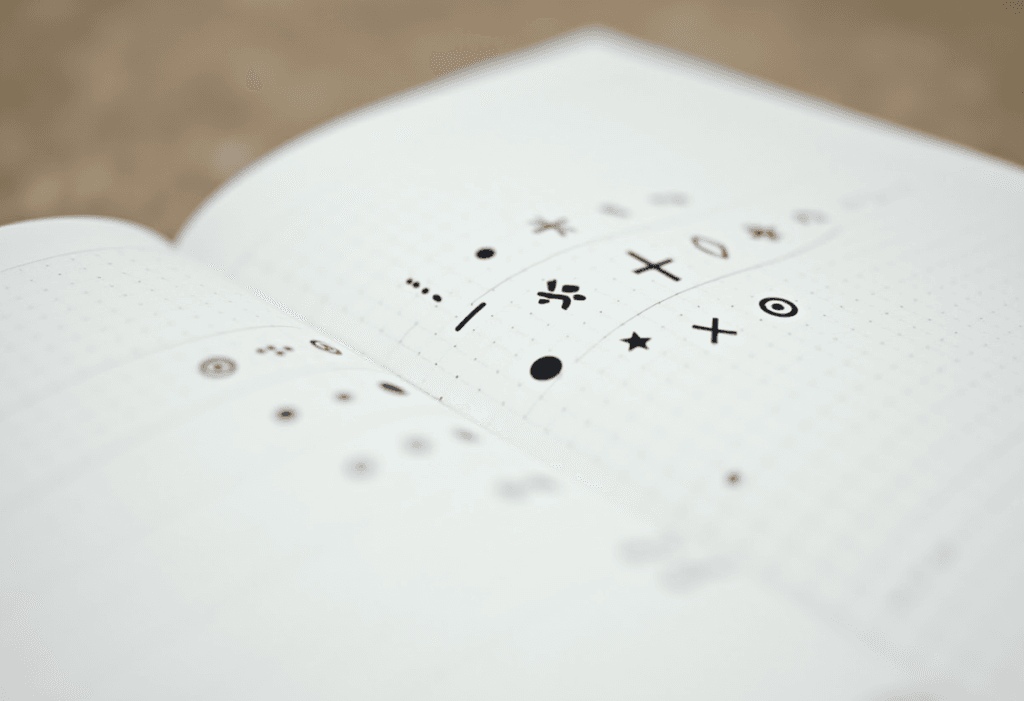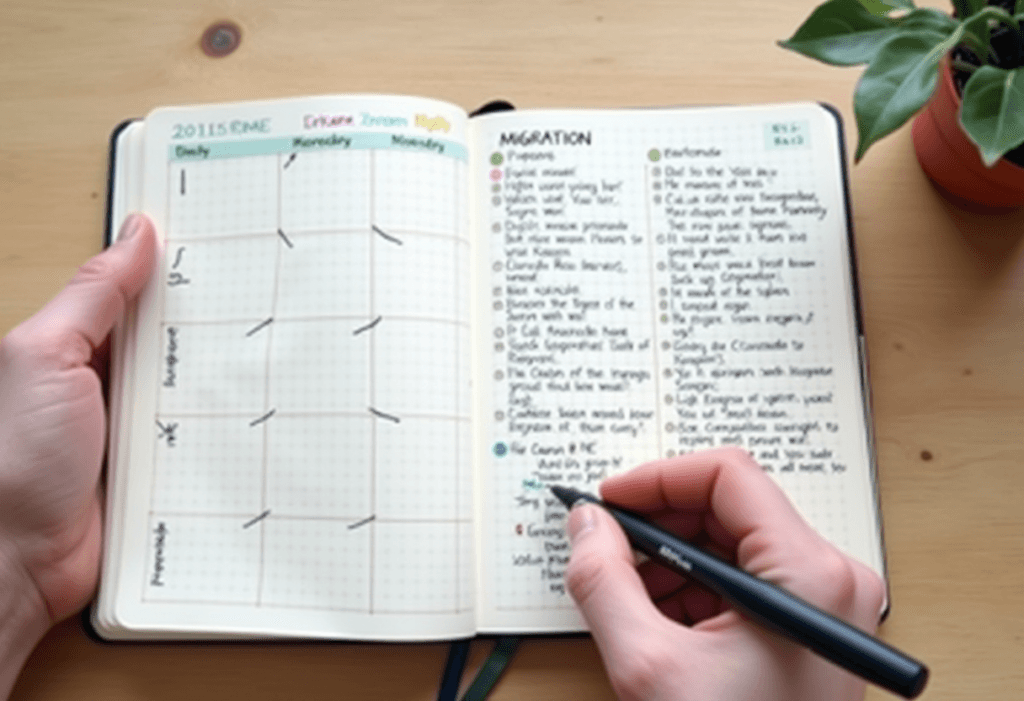Research from the American Psychological Association reveals that 77% of Americans regularly experience physical symptoms caused by stress, yet only 37% feel they’re managing it effectively. This growing disconnect between stress levels and effective coping mechanisms mirrors what educators and mental health professionals observe in their practice—an increasing need for accessible self-management tools. Many are asking, “What is bullet journaling?” as they search for solutions. Through this structured yet flexible system, individuals are discovering a practical method to organize tasks, track habits, and process thoughts in a single, customizable notebook. Understanding what is bullet journaling reveals an analog planning system that has gained significant traction among students, professionals, and creative individuals seeking a tangible alternative to digital planning tools. Readers will discover how this practical methodology works, explore its core components and learn how to implement this system to enhance productivity and mindfulness in their daily lives.
What is Bullet Journaling?
Classroom educators report that students who utilize visual organization systems show improved executive functioning skills and retention of information. So, what is bullet journaling in its most basic form? Developed by designer Ryder Carroll in 2013, bullet journaling represents a methodical approach to note-taking and planning that combines to-do lists, calendars, and trackers in a single, customizable notebook. The system utilizes a language of symbols—called signifiers—to quickly categorize information and prioritize tasks. Unlike pre-formatted planners, a bullet journal (often abbreviated as BuJo) adapts to the individual’s specific needs, allowing for both structured planning and creative expression. When exploring what is bullet journaling at its core, the philosophy emphasizes intentionality and mindfulness, encouraging users to reflect on tasks and commitments before recording them.
Many who discover this system find it refreshingly analog in our digital world. The physical act of writing creates a natural pause that encourages more deliberate choices about how to spend time and energy. Middle school teacher Sarah Hernandez notes, “When my students switched from digital planners to bullet journals, I noticed they became more selective about what commitments they took on. The act of writing seems to create a moment of reflection that digital inputs often skip.”
The Core Components of a Bullet Journal
Mental health professionals consistently observe that structured externalization of thoughts reduces cognitive load and anxiety. The bullet journal system consists of several key organizational elements that work together to create a comprehensive planning experience:
Index: This serves as the journal’s navigation system, allowing users to quickly locate specific pages or collections. Unlike a traditional table of contents, the index grows organically as new pages are added.
Future Log: This provides an annual overview where users record events, goals, and deadlines that will occur months in advance. The future log ensures long-term planning doesn’t get lost in daily details.
Monthly Log: This offers a more immediate planning horizon, typically containing a calendar page and a task page for the current month. This dual view balances time-specific commitments with flexible task lists.
Daily Log: This captures the granular details of each day, including tasks, events, and notes. The daily log serves as the primary workspace for most bullet journalists.
Collections: These specialized pages dedicated to specific topics, projects, or lists allow for customization beyond standard planning. Examples include habit trackers, reading lists, or project plans.
Migration: This process of moving unfinished tasks forward ensures nothing falls through the cracks while simultaneously encouraging users to evaluate the continued relevance of incomplete tasks.
School counselor Robert Chen explains, “The structure of the bullet journal gives students just enough framework to stay organized without feeling rigid. The combination of future planning with daily flexibility seems to particularly benefit those with executive functioning challenges.”
The Bullet Journal Method: Rapid Logging
Research from productivity experts at Harvard Business School indicates that visual processing of information increases retention by up to 65% compared to text-only formats. Rapid logging, the backbone of the bullet journal method, offers a streamlined notation system designed for efficiency. This shorthand approach utilizes bullets, signifiers, and short phrases to quickly capture information:
Bullets: Different shapes create visual differentiation that allows for quick scanning:
- Tasks (•): Actionable items that need completion
- Events (○): Time-specific occurrences, meetings, or deadlines
- Notes (—): Facts, observations, or thoughts worth recording
Signifiers: Additional symbols that add context to entries:
- Priority (*): Marks important tasks
- Inspiration (!): Highlights good ideas or insights
- Exploration (→): Indicates items needing further research
This structured approach to information capture allows users to document thoughts and tasks without interrupting workflow or losing momentum. Productivity coach Jennifer Mills notes, “The genius of rapid logging is that it’s fast enough to use in meetings or conversations but structured enough to remain meaningful when reviewed later.”
How to Start a Bullet Journal
Educational consultants working with executive functioning challenges note that students who establish clear setup routines show greater consistency in maintaining organizational systems. Beginning a bullet journal requires minimal materials—typically just a notebook and pen—making it accessible regardless of budget. While dedicated bullet journal notebooks with numbered pages and dot grids enhance the experience, any notebook can serve as a starting point.
The initial setup involves creating key reference pages:
- Reserve the first few pages for your index
- Create your future log for the year
- Set up your first monthly log
- Turn to the next available page for your first daily log
Educators recommend establishing a regular “journaling appointment” to review and update entries, which builds consistency and ensures the system remains current and useful. High school English teacher Marcus Rodriguez shares, “I’ve found that students who spend 5-10 minutes with their journals at both the beginning and end of each day form the most sustainable practice. The morning review sets priorities, while the evening session processes the day and prepares for tomorrow.”
For those seeking additional inspiration to jumpstart their practice, our companion guide 15 Essential Bullet Journaling Ideas for Beginners offers a collection of creative spreads and layouts specifically designed for newcomers.
Bullet Journal Keys and Signifiers
Cognitive psychologists have documented that symbolic representation of information allows for faster processing and enhanced mental categorization. The bullet journal key—a personalized legend of symbols—serves as the coding system that transforms simple marks into meaningful information. Standard signifiers include:
- Tasks (•): Actionable items requiring completion
- Completed (✓): Tasks that have been finished
- Migrated (>): Tasks moved to a future date
- Scheduled (<): Tasks added to a calendar
- Events (○): Time-specific occurrences
- Notes (—): Information worth recording
- Priority (*): Important tasks or information
- Inspiration (!): Ideas or insights
While the original bullet journal method recommends specific symbols, many practitioners adapt and expand the system to include emotion tracking, energy levels, or other personal metrics. This customization allows the journal to capture not just what needs to be done, but also contextual information about the user’s state of mind.
Mental health counselor Amira Hassan explains, “Many of my clients create custom signifiers to track anxiety levels, medication effects, or triggers. This personalization helps them identify patterns they might otherwise miss and provides valuable data we can use in therapy sessions.”
Bullet Journal vs. Traditional Journaling
Research published in the Journal of Experimental Psychology demonstrates that structured reflection exercises produce greater insights than free-form journaling for most participants. When comparing what is bullet journaling to traditional methods, significant differences emerge. Traditional journaling typically involves long-form, narrative writing that processes emotions and experiences chronologically. In contrast, bullet journaling takes a more structured, concise approach focused on organization and productivity.
While traditional journals often emphasize past reflection, bullet journals balance past documentation with present tracking and future planning. Understanding what is bullet journaling in practice means recognizing that many users find value in combining elements of both approaches—using rapid logging for daily planning while incorporating longer reflective writing for processing significant events or complex emotions. This hybrid approach allows for both efficient task management and meaningful self-reflection.
Writing instructor Cynthia Park observes, “Students who struggle with traditional journaling often find the bullet journal format more approachable. The structured format seems to reduce the intimidation of a blank page, while still offering space for deeper reflection when needed.”
Benefits of Bullet Journaling for Mental Health
Clinical studies from the University of Rochester Medical Center show that externalized planning systems reduce cognitive load by approximately 30%, freeing mental resources for problem-solving and creativity. For those wondering what is bullet journaling’s impact on mental wellness, the system provides several psychological benefits, including reduced anxiety through externalized organization and enhanced mindfulness through intentional planning. The physical act of writing has been linked to improved memory retention and cognitive processing.
Additionally, the customizable nature of bullet journaling allows users to incorporate mental health tracking, mood monitoring, and gratitude practices that support emotional well-being. Therapists increasingly recommend bullet journaling as a supplementary tool for patients with anxiety, ADHD, and depression, as it creates structure while promoting agency and self-awareness. Understanding what is bullet journaling from a mental health perspective reveals its potential as both an organizational system and therapeutic practice.
Clinical psychologist Dr. James Chen explains, “What makes bullet journaling particularly effective for anxiety management is the way it externalizes worries and creates containment. By capturing scattered thoughts in an organized system, patients often report feeling more in control and less overwhelmed.”
Bullet Journaling for Productivity
Workplace efficiency researchers have found that individuals who regularly review and prioritize tasks complete approximately 23% more high-value work than those who use unstructured to-do lists. The bullet journal system enhances productivity through several mechanisms:
- Task Migration: Regular review and prioritization reduces the tendency to carry forward low-value activities
- Visual Patterns: The journal helps identify patterns in productivity and time management
- Project Tracking: Dedicated collection pages provide clear oversight of multi-step processes
- Digital Separation: Physical planning creates distance from digital distractions
- Workload Visibility: Making the full scope of commitments visible prevents overload
Business professionals report that the bullet journal method helps clarify priorities and prevent task overload by making workloads visible and manageable. Project manager Devon Williams notes, “Our team converted to a modified bullet journal system for project tracking last year. The visual nature of the system has dramatically improved our ability to identify bottlenecks and resource allocation issues before they become critical.”
Creative Elements in Bullet Journaling
Art educators observe that incorporating visual elements into organizational systems increases engagement and consistency among students by approximately 40%. While the original bullet journal method emphasizes function over form, many practitioners incorporate artistic elements that enhance both aesthetics and functionality:
- Color Coding: Using different colors to categorize information or indicate priority
- Hand Lettering: Creating emphasis through varied typography
- Simple Illustrations: Adding visual elements that enhance engagement
- Decorative Themes: Applying consistent visual motifs to create cohesion
- Washi Tape and Stickers: Using pre-made decorative elements for efficiency
Research indicates that personalization increases system adherence, with users reporting they’re more likely to maintain journals that reflect their personal aesthetic. However, education specialists emphasize that artistic elements should enhance rather than impede the core organizational functions.
Art therapist Maya Johnson cautions, “While creative expression can significantly increase engagement with the journaling process, some clients become so focused on perfect execution that they lose sight of the functional purpose. I encourage starting with minimal decoration and gradually adding artistic elements as the organizational habits become established.”
Digital vs. Analog Bullet Journaling
Neuroscience research published in Psychological Science demonstrates that handwriting activates neural circuits that support learning in ways digital typing does not. The traditional bullet journal exists in a paper notebook, offering tangible benefits including reduced screen time, enhanced memory through physical writing, and fewer distractions.
However, digital bullet journal applications provide advantages in searchability, backup capabilities, and integration with other digital tools. Some practitioners adopt a hybrid approach, using paper journals for daily planning and reflection while maintaining digital archives or specialized collections.
Technology integration through QR codes, reference photos, or synchronized task management allows users to leverage the benefits of both analog and digital systems while minimizing their respective limitations. Computer science teacher Leon Garcia observes, “Students who struggle with handwriting or organization often find digital bullet journal apps more accessible. The key is maintaining the intentional planning aspect regardless of the medium used.”
Common Bullet Journal Spreads and Layouts
Educational design specialists note that information presented in structured visual formats improves comprehension by 36% compared to linear text. Beyond the core system, bullet journal practitioners have developed numerous specialized page layouts for specific purposes:
- Weekly Spreads: Bridge the gap between monthly and daily planning
- Habit Trackers: Monitor consistency in behaviors and routines
- Mood Trackers: Visualize emotional patterns over time
- Goal-Setting Pages: Articulate and track progress toward objectives
- Reading Logs: Document books read or to be read
- Meal Planners: Organize nutrition and food preparation
- Expense Trackers: Monitor spending and budget adherence
Educational consultants observe that students who implement custom spreads aligned with their particular challenges show significant improvements in targeted skill areas, suggesting the value of tailoring layouts to individual needs. Special education teacher Patricia Nguyen shares, “One of my students with severe math anxiety created a ‘math victories’ spread in her bullet journal. This simple tracking system has completely transformed her relationship with the subject by making progress visible and celebrating small wins.”
Bullet Journaling for Special Needs and Conditions
Research from occupational therapists at Johns Hopkins University indicates that customized planning systems increase task completion by 47% among individuals with executive functioning challenges. The adaptable nature of bullet journaling makes it particularly valuable for individuals with conditions that affect organization and planning:
- ADHD: The visual structure provides external scaffolding for executive function
- Anxiety: Containment and externalization reduce rumination and worry
- Depression: Tracking mood and activities helps identify patterns and triggers
- Learning Disabilities: Personalized adaptations support specific challenges
- Chronic Illness: Symptom tracking provides valuable data for treatment
Mental health professionals increasingly recommend modified bullet journaling approaches tailored to specific cognitive and emotional needs. Occupational therapist Susan Kim explains, “For clients with ADHD, we focus on simplified layouts with high visual contrast and limited color coding. This maintains the organizational benefits while accommodating challenges with sustained attention and working memory.”
Avoiding Common Bullet Journal Pitfalls
Productivity researchers have found that approximately 64% of new organizational systems are abandoned within two months due to perfectionism and complexity. Several common challenges can undermine the effectiveness of bullet journaling:
- Perfectionism: Excessive focus on aesthetics can lead to abandonment
- Over-Complication: Too many collections or elaborate systems diminish practicality
- Inconsistency: Skipped journaling sessions create unreliable gaps
- Comparison: Social media showcases can create unrealistic expectations
- Rigidity: Failure to adapt the system to changing needs reduces relevance
Education specialists recommend starting with minimal layouts, focusing on functional rather than aesthetic elements, and establishing regular review periods scaled to individual capacity and needs. This pragmatic approach increases long-term adherence and system effectiveness.
Business coach Alicia Washington advises, “I tell clients to think of their bullet journal as a prototype for the first three months—expect to make changes, focus on function over form, and be willing to abandon elements that don’t serve them. This experimental mindset prevents the all-or-nothing thinking that often leads to abandonment.”
Resources for Bullet Journal Beginners
Librarians report that bullet journaling resources consistently rank among the most requested self-improvement materials across public library systems nationwide. New bullet journalists can access numerous resources to develop their practice:
- Books: Ryder Carroll’s “The Bullet Journal Method” provides authoritative guidance
- Online Communities: Forums and social media groups offer inspiration and troubleshooting
- Video Tutorials: Demonstrate techniques for various spreads and artistic elements
- Printable Templates: Help establish consistent layouts without starting from scratch
- Workshops: In-person or virtual classes provide structured learning environments
Educational consultants recommend that new practitioners begin with minimal investment in materials, focusing on learning the core system before expanding into more specialized applications or artistic enhancement. Community college instructor Teresa Mendez shares, “I encourage students to start with whatever notebook they have on hand. The accessibility of the system is one of its greatest strengths—anyone can begin with just pen and paper, regardless of budget constraints.”
Conclusion
The question “what is bullet journaling” ultimately reveals a versatile approach to organization that balances structure with flexibility. By combining planning, tracking, and reflection in a single, customizable notebook, this method addresses multiple needs simultaneously. Educators and mental health professionals observe that the most successful bullet journal practitioners are those who adapt the system to their specific circumstances rather than following prescriptive models.
Beginning with the basic methodology and gradually incorporating personal modifications creates a sustainable practice that evolves alongside changing needs. Whether seeking improved productivity, enhanced mindfulness, or better habit management, bullet journaling provides a framework that can be tailored to support these goals through intentional, analog organization. With a clear understanding of what is bullet journaling and its potential benefits, individuals can confidently begin their own analog planning journey.
As elementary school principal David Ramirez reflects, “What makes bullet journaling so powerful in educational settings is its balance of structure and flexibility. Students learn organizational skills while simultaneously developing agency over their planning systems. This combination of guided practice with personal autonomy creates sustainable habits that extend far beyond the classroom.”








